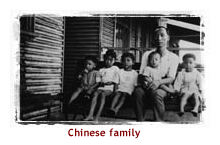Multi-racial Western Australia"For me childhood was quite fun because as a child you grew up with other children because I can remember there was a Greek family, there were Italians, there was the odd Japanese. So as a child you never noticed anything different except maybe at school. You did notice that in school because when you only had a class of maybe 50 or 60 children and you had a few minority children there, then the Aussie kids would say something. But as a child then nothing hurt except when I used to go to school my father used to prepare food that was typically Chinese. Sometimes the children would come along and say, 'What are you eating? It smells.' Or 'It stinks' or something because they weren't used to the different smells. Then I noticed that there was something different. And every now and again in the playground if you had a blow up, and perhaps I'd have a nice hat because my father had a business, then they'd grab hold of that and they'd stamp it on the ground and they'd say such things as 'Chin Chong Chinaman'. But that also was new and as a child you just took it. My father used to get very upset about it but I just said, 'Oh it's all right. They didn't belt me or anything. They're just names, you know'. You sort of grew up with that: 'Sticks and stones will hurt my bones but names will never hurt me'.  Mrs
Edie Hoy Poy grew up in Port Hedland during the 1930s in one of the small
communities of Chinese, Malays and Japanese who lived and worked in the
north of Western Australia. As an Australian-born Chinese, her father was
one of many Chinese who came to Australia prior to Federation, often as
indentured labour. They and their families remained, in spite of the White
Australia Policy, and were part of the many different races and nationalities
which have always lived in small numbers in the State. Mrs
Edie Hoy Poy grew up in Port Hedland during the 1930s in one of the small
communities of Chinese, Malays and Japanese who lived and worked in the
north of Western Australia. As an Australian-born Chinese, her father was
one of many Chinese who came to Australia prior to Federation, often as
indentured labour. They and their families remained, in spite of the White
Australia Policy, and were part of the many different races and nationalities
which have always lived in small numbers in the State.But it was not until the 1970s that Western Australia began to become truly multi-racial. The influx of migrants from all over the world made Western Australia a more racially diverse society and brought with it the benefits of multi-culturalism. |
Please note: The content on this website is made available for archival purposes and may not meet the State Library of Western Australia's current standards for web accessibility, mobile device compatibility, historical accuracy and cultural sensitivity.